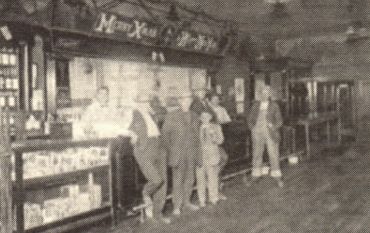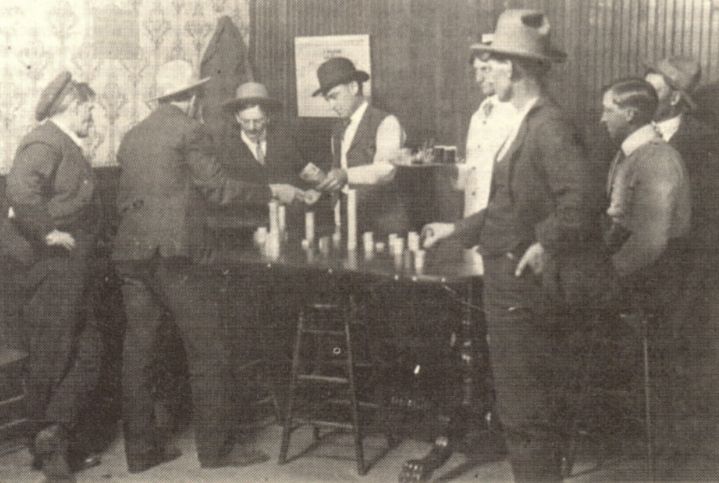THE MYSTERIOUS HAMILTON CASE
by Hooker County Historical Society
Entry T103 from the History of Hooker County Nebraska
with permission of the Hooker County Historical Society

Old saloon where Dutton's Store was, now The
Rustic Lounge, before 1910. L-R: Charles Rector,
Judge Bowers, George Lowe (small man), unknown,
Emerson Main, Jim Conn.

Old Saloon where Duttons' store was- now is the Rustic Lounge Before 1910 L to R
O.F. Hamilton, Unknown, Charles Rector, Bob McBride, Frank Cleavenger, Harry
McIntyre, Emmet Long, and unknown
The following information was taken in
part from Mullen Round-Roundup 1884-
1917, published in 1940, also the North
Platte Telegraph March 1, 1967 North
Platte, Nebraska and the Lincoln State
Journal January of 1906 and the files of
Hooker County Historical Society.
O. F. Hamilton came to Mullen in 1901. He
earned his living partly by knowing some-
thing about law and by being a "locater".
Hamilton became well informed about the
available government lands in this area and
he profited by helping prospective homes-
teaders find desirable acreages for their
claims.
This occupation wasn't conducive to mak-
ing friends with the ranchers who were using
the public lands for their open ranges.
Hamilton saw that cattlemen were disregard-
ing the law by filing illegal claims and by
fencing government owned public lands. He
was partially responsible for bringing two
Mullen ranchers to trial. They were later
tried, convicted, and sent to jail in Grand
Island, Nebraska.
Three big outfits, the UBI, and Spade, and
The Standard Companys had been using
most of the Sandhill Range land in this area.
These outfits had come from Montana,
Wyoming, and South Dakota.
Among charges wrought by the settlers was
local prohibition in Mullen, which had
maintained 3 wide open saloons until the
women of the town banded together and got
them closed. One of the proprietors, Bob
McBride, turned his saloon into a `blind pig'
and stayed in business. The prohibitionist
then gathered evidence, Hamilton, the chief
one, charged McBride with illegal operation
of a saloon. Before the trail came to court,
Hamilton disappeared.
Two years later his body was dug up from
a shallow grave in the Mullen stockyards. The
remains were laid out in a boxcar on the track
nearby, while a coffin was being secured. The
remains were identified by the clothes, finger
ring, mustache, etc. and a ragged hole in the
skull.
The Lincoln State Journal reported in
January of 1906, when Hamilton was in
Omaha giving testimony before the Federal
Grand Jury, that two parties were ap-
proached and offered $1,000 each if they
would get Hamilton out of the way on his
return to Mullen.
A story told by Tom Quinn follows in part:
In 1908, Hamilton had gone to the `blind pig'
to get a drink which resulted in many drinks.
When it was time for the saloon to close, he
was asked how he was going to testify against
McBride. He replied "Tell the truth". This
conversation was passed on to McBride that
night and he responded by saying he would
pay a $1000 to the one that drew the shortest
straw - "to rub him out". Frank Cleavenger,
Charlie Rector, Harry McIntyre, good friends
of McBride, talked it over and decided to do
it. Frank, the youngest, hardly more than a
boy, drew the short straw and backed out.
Then McIntyre walked over to the half
unconscious Hamilton and hit him on the
head till he fell to floor, bleeding from the
hole in his head.
At that moment, Tom and 3 other men
from the UBI Ranch rapped on the locked
door of the saloon for admittance to `get a
round of drinks' but was advised "wait a
minute." When they went in they noticed
sweeping compound on the floor but thought
nothing of it. They had one round of drinks
and left with the feeling that they were
unwelcome. Tom and the others had forgot-
ten the incident until Hamilton's body was
discovered two years later, 1910 and the rest
of the story unraveled.
A Secret Service Agent, posing as a farm
hand made friends with Cleavenger, who had
drawn the short straw. The agent was
working on this case as one of the first cases
that the Bureau of Investigation had acted
upon due to the fraudulent land claims and
the disappearance of the locator, Hamiliton
in the Sandhills. This Bureau had been
created by President Theodore Roosevelt in
July of 1908.
After a period of time attending various
activities with Cleavenger and gaining his
friendship, the agent made the remark that
killing a man was easier after the first one and
Cleavenger replied that he never had killed
anyone but he had seen a man killed once.
This was what the agent had been waiting to
hear, so he took his prisoner back to Mullen
where Clevenger related the whole story, how
when the knock was heard from the UBI
boys, the body was stuffed in a celler hole,
sweeping compound was used to cover up the
blood on the floor and then afterwards, the
men loaded the body in a car to bury in the
stockyards. Cleavenger then showed the
agent, Sheriff Cloyd and some others the
buried spot.
The State charged Harry McIntyre, a
Seneca railroad brakeman, with murder.
Charlie Rector was brought back from Wash-
ington as a witness and Tom Quinn was
subpoenaed to appear in court, and anyone
who knew anything about the murder. The
body was found April 1910 and the trial was
set for June. Homer Sullivan of Broken Bow,
Nebraska represented the defendant and
Willis Oldhan the State. Sullivan insisted he
see the body before the trial and Tom Quinn
opened the grave. Sullivan demanded to see
the head which disclosed the hole in the skull.
When the grave was opened a second time by
Quinn on demand that the skull be used as
evidence, Tom knew it was a different head,
no hole in the skull and in the court it was
proved to be the skull of a black man. Tom
recalled to mind, a negro, two years previous-
ly had been killed by a train in Hecla and
buried beside the tracks. He rode later to the
spot which proved his suspicion was right, the
sunflowers around the grave had been newly
disturbed.
Although the confessing witness, while on
the stand, related the whole story of the
murder, Sullivan's defense was successful
and McIntyre walked from the courtroom a
free man. "The body recovered was not
proved beyond a reasonable doubt to be
Hamilton's and the skull showed no frac-
tures."

